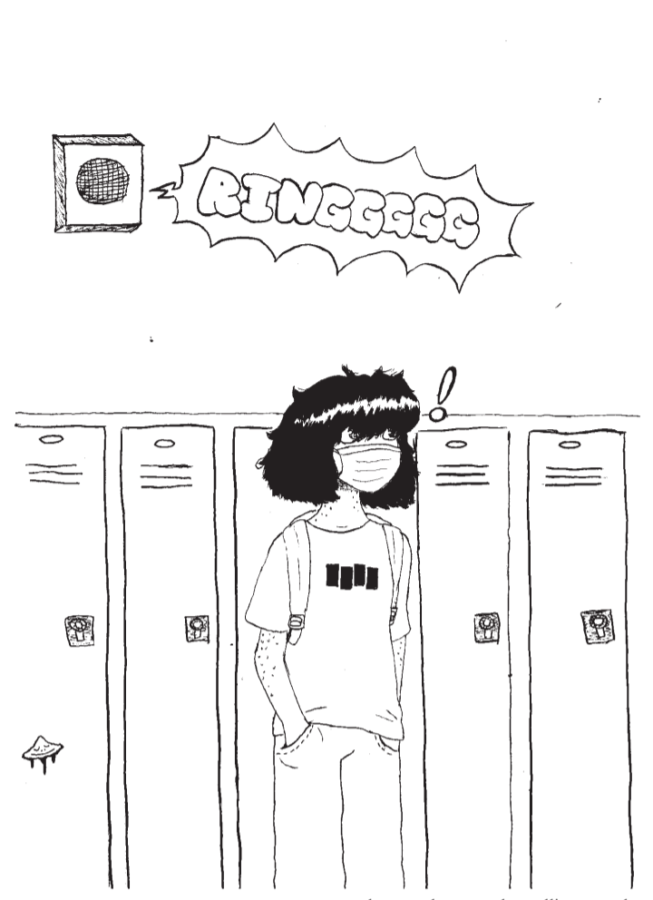Opinion | Rehumanizing ETHS comes with significant adjustments
Linnea’s thoughts
Going into this school year, there were various expected changes awaiting students and staff, including the block scheduling, 85-minute class periods and no tardies that we had been informed about last spring. However, after my first class on the first day, I was surprised to hear what sounded like three airport chimes below from the hallway speakers, and my teacher telling our class that these were the new school bells indicating the passing period. Very different from the loud, distinct bell I remembered from my freshman and sophomore year, this bell change was one of the unexpected changes ETHS has made in an attempt to make this school year more humane after the disconnected last 18 months. Another unexpected change was the musical interlude, different from the Friday song, between the lunch periods.
While both of these changes seem small, they raise the question of normality and its possibility at ETHS. In June of this summer, ETHS sent out an email to students and staff, saying “ETHS is returning to a space that dehumanizes our school community…ETHS will work to build relationships and a sense of belonging.”
In the state of reconstruction, we’re in after the last year and a half, these goals are especially important to rebuild the community that was lost virtually. So, are ETHS attempts at fostering a more humane school environment possible?
To a certain extent, yes. With students finally being back in the building, we’re all adjusting to and navigating the situation together and making the best of what we’ve been given. I find myself grateful for the chance to spend my senior year in person, getting to meet my teachers and peers in person for the first time in what feels like forever. Everyone is recovering from the hardships of last year, putting us in a place of rebuilding and recognizing what we thought our school environment should be.
“I think we recognized that schools aren’t a humanizing space and as much as we want to try to create that, there are systemic things that get in the way, there are issues with the power dynamics in schools and state requirements, so we’re really trying to see the areas that we do have some control over and agency in, how can we make that a more humanizing space and give back to recognizing the relational pieces that make schools?” says Associate Principal for Instruction and Literacy Scott Bramley.
Throughout the last year, it was clear ETHS wasn’t afraid to make changes and create space for students and staff.
“A driver [for these changes] was just realizing that we didn’t want to come back to ETHS the way we were doing it before. There were opportunities to change some things structurally, to change things for everyone involved…Trying to do this for the foreseeable future, one of the things we committed to is we’d make minor revisions each year after we lived it and learned it.” explains Bramley.
So, while the countless questions and lack of information still hangs in the air, how do we attempt to return to normal when there’s so much we just don’t know?
With this unclarity, it becomes difficult to walk down the halls without questioning the lack of distance in the crowds or the people with their masks below their noses. The thought of going to school without a mask mandate, something ETHS had announced back in July but later adjusted, is also of constant questioning considering the state we’re in. Though being vaccinated certainly eases that stress, the worry of COVID-19 is constantly at the back of my mind, and one of the most obvious reasons ETHS will likely never return to complete normalcy anytime soon. Instead, we adjust and adapt to changes.
Maddie’s thoughts
The changes ETHS made, with this upcoming school year, can amount to a level of disconnect among the student body. These tactics seemingly meant to rehumanize ETHS for its student population, may end up resulting in drastic changes that deny students the opportunity to acclimate themselves with their school environment. We all just returned from an unorthodox year and a half, to say the least, and for ETHS to come back following that period with countless changes, large and small, it can be expected that there will be a bit of a push-back and lack of connection students have with the school.
Half of the student body was used to their high school functioning a certain way. They knew 42-minute class periods, having all their classes in one day, five-minute passing periods, having lunch in a designated location, announcements during third period and a specific type of bell. Now, that is all different. Not to say that all of these rehumanizing changes are bad, but when a decision is made to make exceedingly exorbitant changes all in one school year—especially one following not being in the building, learning online, and having to deal with plenty of other external stressors—we, as students, should not be expected to welcome these all with open arms.
For many students, teachers and staff alike, the return to school has been seen as a return to normalcy. Even though we are still experiencing the effects of the pandemic still raging across the nation and globe, the decision made for ETHS to return to in-person learning was seen as a victory. No more awkward Zoom calls or breakout rooms. No more internet failing or lack of connection with teachers and students. The in-person schooling formula could acknowledge the hardships and struggles many faced under online learning while also building back the daily connections that had been lost. Yet, these rehumanizing changes that had been made, make a “return to normalcy” impossible for some students, given the drastic shift in the daily engagements of the new school environment.
While, at least for this year, the rehumanizing changes are here to stay, small structural shifts can allow for a better connection and ability for students to readjust to their new learning environment. This can be as simple as giving students small breaks during class (due to many struggling with the constant, attentive nature required of us throughout in-person learning), or even offering more clarity to the school year and how it is meant to function as a whole. The shifts, following a jarring break, from being within the physical walls of ETHS may have been a bit too fast and furiously made, in cumulation, further work must be done in order to offer a better connection and support to those who are not used to the new, rehumanizing tactics.
Your donation will support the student journalists of the Evanstonian. We are planning a big trip to the Journalism Educators Association conference in Philadelphia in November 2023, and any support will go towards making that trip a reality. Contributions will appear as a charge from SNOSite. Donations are NOT tax-deductible.
















